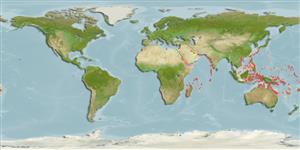Hexacorallia |
Scleractinia |
Poritidae
Environment: milieu / climate zone / depth range / distribution range
Ecology
Reef-associated; depth range 2 - 18 m (Ref. 107467). Tropical
Indo-Pacific.
Length at first maturity / Size / Weight / Age
Maturity: Lm ? range ? - ? cm
Color is uniform light brown, with the mouth occasionally being light purple. Colony shape tends to look larger and massive when masked by the tentacles. Its normal columnar shape becomes more prominent when disturbed. Corallites are crowded, having little coenosarc (Ref. 130769).
Occur in both shallow and deeper waters. Colony shape tends to look larger and massive when masked by the tentacles. Although when disturbed, its normal columnar shape becomes more prominent. Polyps extend during the day (Ref. 130769).
Life cycle and mating behavior
Maturity | Reproduction | Spawning | Eggs | Fecundity | Larvae
Mature gametes are shed into the coelenteron and spawned through the mouth. Life cycle: The zygote develops into a planktonic planula larva. Metamorphosis begins with early morphogenesis of tentacles, septa and pharynx before larval settlement on the aboral end (Ref. 833).
Nemenzo, F. Sr. 1986 Guide to Philippine Flora and Fauna. Corals. Natural Resources Management Center, Ministry of Natural Resources and University of the Philippines. 5:273 pp. (Ref. 910)
IUCN Red List Status
(Ref. 130435: Version 2025-1)
CITES status (Ref. 108899)
Not Evaluated
Threat to humans
Human uses
| FishSource |
Tools
More information
Trophic EcologyFood items (preys)Diet compositionFood consumptionPredators Population dynamicsGrowth
Max. ages / sizes
Length-weight rel.
Length-length rel.
Length-frequencies
Mass conversion
Abundance
PhysiologyOxygen consumption
Human RelatedStamps, coins, misc.
Internet sources
Estimates based on models
Preferred temperature
(Ref.
115969): 24.8 - 29.3, mean 28.5 (based on 1512 cells).
Price category
Unknown.
